California Crawfish Dreaming In the Sacramento–San Joaquin Delta, Louisiana red crawfish offer a taste of home.
by Katie Carter King
illustrations by Molly Brooks
![]()
It’s 11:30 a.m. on a breezeless Sunday in late June—Father’s Day—and people are hungry.
More than 250 festivalgoers wait on hot asphalt in a snaking but orderly queue, chatting with each other in various languages. Two elementary school–aged boys are hard at play, weaving through adult legs, as their parents gulp warming beers. Dozens of vendors line Main Street, hawking everything from grilled oysters to beignets to turkey legs, but few appear interested in their offerings. For the first time in fourteen years, the town of Isleton, California, is hosting the two-day Isleton Crawdad Festival, and crawdads are what people want.
On this side of the Diablo Range, the mountains that form a natural barrier to the cool Pacific air, the June heat is vicious. Although the festival gates opened an hour and a half ago, we’re told the mudbug-heavy takeaway boxes—one pound for twenty-five dollars, three for sixty—won’t be ready for another fifteen minutes at least. Founded in 1986, the beloved festival drew huge crowds to the half-square-mile town every summer for twenty years, until small-town infighting between the city council and local chamber of commerce destroyed the event. One local politician even claimed the chamber put “daggers in everything we do.” But no one is thinking about those harsh words from 2006 today. Everyone is just excited the Crawdad Festival is finally back.
Halfway down the ever-growing line, local attorney Matt Schumacher isn’t bothered by the temperature or the tardiness. He’s enjoying talking with the other crawfish-obsessed as he waits for his son to return with refreshments. The third generation in a career-military family, Schumacher was born on Travis Air Force Base, about thirty miles northwest of where we now stand. Although his family is originally from the Midwest, bases along the Gulf Coast brought them south before moving them west. “There are a lot of people around here from Mississippi, Louisiana, largely because of Travis,” Schumacher explains.
Isleton, California (population 797) rests at ten feet above sea level, tucked beneath the leveed banks that form the northern edge of Andrus Island, one of almost 200 islands carved out by the confluence of the Sacramento and San Joaquin rivers. Bridging the distance between the Bay Area and Sacramento, a dozen half-empty Delta towns dot the soft edges of quiet sloughs, artifacts of bygone economic boom times brought by agriculture and industry. While Schumacher drove down for the day’s festivities from nearby Vacaville, roughly thirty-five miles north, his son, Matthew, traveled more than an hour to join him for the day. Today, State Route 160 is a parking lot, with cars stretching for miles down the black-topped levee. Tens of thousands of visitors from the surrounding counties have descended on Isleton’s tiny downtown, a fever dream flush with perspiration and Zatarain’s seafood boil.
Standing behind white-haired women in umbrella-capped folding chairs, Schumacher explains to me that while he is not technically from the South, he still considers himself Southern. Growing up in a career-military family, his parents moved him and his three brothers all over the country. “Florida. Boston twice. New Orleans, Alabama. New York,” Schumacher said. “I grew up everywhere. But Mississippi was—in air quotes—home.” His grandparents moved to Biloxi from Illinois when his grandfather was stationed at Keesler Air Force Base. After his grandfather’s death in the early 1950s, Schumacher’s grandmother remained. His uncles returned to the Gulf Coast after their own stints in the military; some found work at the nearby Ingalls Shipyard in Pascagoula. Mississippi became, and remained, the family’s center of gravity.
Schumacher’s father followed the trajectory of the rest of the men in his family: enlisting in the Air Force before spending the bulk of his career as a military contractor. Each summer, Matt and his brothers returned to the Gulf Coast, where equal parts work and play awaited them. Their uncle Larry, a retired master sergent turned commercial fisherman, would host a large fish fry to herald their homecoming, a backyard party full of just-caught mullet, shrimp, and crawfish. He’d put the second generation to work: “We’d set up the foldable table in the backyard. It was just an assembly line,” Schumacher remembered. “I can still strip shrimp probably faster than anybody in California,” he said, laughing. Sometimes, when the coast was pelted by summer storms, the cousins would run through medians and along roadsides to harvest the flooded-out mudbugs. These moments of camaraderie remained indelible, long after those summers came to an end; long after he grew up and had a son of his own.
Despite what the festival’s turnout might imply, northern California has not always been a crawfish-eating destination. While this expanse of western land was once home to three native species, since Europeans began arriving in 1769, crawfish were primarily used as fishing bait—a tool of sustenance, rather than sustenance itself. Even so, all three are now either endangered or extinct. Other species of crawfish are the primary culprits, chief among them the red swamp crayfish, Procambarus clarkii. In the Gulf South, these are affectionately termed Louisiana reds.
No one knows exactly how they first came west, but there are plenty of theories, each sounding more folkloric than the last. As Isleton Crawdad Festival founder Susan Ramon explained to me, “In the late 1930s, early 1940s, a Frenchman from Louisiana… trucked in Louisiana red crawfish and infiltrated the northern California rice fields.” Maybe it happened that way; maybe it didn’t. Others suggest they crept up from southern California after a bullfrog farmer in San Diego County imported them to feed his army of amphibians in 1932. No matter how they arrived, armed with oversized vermillion claws and a notoriously aggressive nature, reds quickly conquered irrigated and leveed waterways throughout the state.
Since California’s incorporation into the continental United States in 1848, white men, typically from New York or New England, had dominated emigration to the Golden State. While industrialists initially enticed Chinese and Japanese laborers to build levees and railroads across the state, rising xenophobia and federal immigration policies curbed this migration after the Civil War. As economic historian James Gregory wrote, “Like the Midwest, California’s population was emphatically Euro-American,” remaining 90 percent white until the start of World War II.
But as Louisiana reds began to proliferate in the state, so did newcomers with a distinct taste for them. Tasked with outfitting the American military for the Pacific Theater in the wake of Pearl Harbor, the federal government began pouring billions of dollars into West Coast defense contractors and weapons programs. By 1946, California was home to 140 bases, 190 naval shipyards, 18 aircraft manufacturers, and 9 landed vehicle factories. Working-class Americans followed the burgeoning job market like a beacon of economic light, bringing migrants from all over the country but especially from the South. Black Southerners went in search of steady employment and racial tolerance—a new life on a golden coast. Whites, too, began to make a small exodus, as farmers across the country walked away from exhausted soil and rising costs. “Second only to the gold rush,” Gregory wrote, “the war remade California.”

For many transplants—far from home, often far from family—the discovery of Louisiana reds in California waters became a tether to the known in this unknown place. And as the state’s population continued to grow and diversify, this taste for mudbugs remained. Scott Brady, a cultural geographer at Chico State in the Central Valley—the sprawling expanse the Sacramento–San Joaquin Delta gives way to—explained me last fall, “Different groups have shown up and created foodways that weren’t here fifty years ago.” When Brady, a native of Thibodeaux, Louisiana, first arrived in California in 2000, he would load his wife and sons into the car on Saturday afternoons to drive around rice fields and sloughs, looking for a good place to lay a crawdad trap. After turning down a series of gravel lanes, he says he’d often encounter Hmong and Mexican families congregating around well-producing waters.
Brady grew up one of five brothers in Louisiana, and on the weekends his father would keep them busy with physical labor. “I think it was so we would stay out of trouble. It kept us occupied in a way that would make us tired,” he said. For Brady, bringing his own two boys into northern California’s irrigated ditches was an extension of this familial ethos: “They would probably say all kinds of terrible things about how many hours we spent in canals by rice fields and ditches.” Although he loves crawfish, he suspects only one of his own sons has retained a palate for them, while the other can only taste the sweat of childhood chores.
But for the Schumachers, California crawfish were primarily about fun and family bonding. When Schumacher and his brothers would return to California, armed with Mississippi know-how, they would set out to catch some mudbugs on their own. “In downtown Sacramento, I used to [fish for them],” Schumacher explained. “They’re in all the little creeks.” While the family was stationed at McLellan Air Force Base just north of the state capital, the teenaged Schumacher boys would walk down the railroad tracks before cutting through the golf course to nearby Arcade Creek to lure mudbugs from their silty holes with cheese-baited string.
Today, Schumacher doesn’t really consider himself a crawfish connoisseur. Rather, the experience of eating crawfish—and mingling with others who do—serves to connect him both to his childhood summers in Mississippi and to his son. Unlike his father, Matthew didn’t grow up fishing in sloughs and creeks for the Southern scuttlers, but instead found and devoured them in the Viet Cajun restaurants that have become increasingly popular throughout California in the last few decades. He also remembers attending springtime crawfish boils when he was a law student at the University of Mississippi. This was the pair’s fifth year in attendance, and Matthew was prepared to eat his father under the table, as he had since he was a kid.
Just when it felt like it couldn’t get any hotter, patience finally paid off. One by one, people began to pass us, their arms heavy with reds. The crawfish had sold out early the day before, and no one was letting their well-earned turn go to waste, with some holding teetering Styrofoam boxes stacked five or six high.
Crustaceans secured, Schumacher and his son made their way a few blocks down to a tent filled with long tables and black folding chairs where big groups laughed together and shared their hard-earned rewards. “Family-style is what I call it,” Schumacher later explained. The offerings weren’t the fresh, perfectly spiced crawfish of his childhood summers on the Gulf; these mudbugs were mild to the point of bland. Yet Schumacher hardly seemed to mind. “Everybody was just interacting with everybody. I liked it a lot,” he said. “Most of us were just excited [the festival] was back.”
Other attendees were less forgiving. A middle-aged woman cut through the lingering queue and stage-whispered, “I don’t need crawfish that bad.” Some complained about the prices. Still more said the mudbugs’ seasoning was a little heavy on the mud, implying they hadn’t been properly cleaned. But many, like the Schumachers, showed up on Father’s Day looking for a hard-to-find taste of home in an unexpected place: eating Louisiana reds under a northern California sky.
The heat broke by mid-afternoon, and once the crawfish ran out, families began to filter out back to their cars. Although they couldn’t have known it then, this would be the last time festivalgoers would be invited to litter the streets of Isleton with bright-red carcasses sucked dry. A private company, The Crawdad Festival LLC, now runs the event. They plan to move it to Cal Expo, the state fairgrounds in Sacramento, with the hope of attracting even larger crowds and providing them with ample parking. It will still happen over Father’s Day weekend, though, just as it always has.
I asked Schumacher recently if he thought he and his son would still go, continue their tradition. He thought for a moment. “Probably. But it won’t be the same.” To his mind, reds—whether at a boil in the South or at a festival out West—are eaten fresh, ideally overlooking the very canals and sloughs they came from. But this June, he’ll still be able to close his eyes in the thick summer heat and get a Styrofoam box laden with mudbugs, seasoned perfectly by the flavor of memory.
Katie Carter King, Gravy’s copyeditor, is a writer and researcher based in San Francisco. A child of the Georgia Piedmont, she is a graduate of the MA program in Southern Studies at the University of Mississippi.
SIGN UP FOR THE DIGEST TO RECEIVE GRAVY IN YOUR INBOX.




